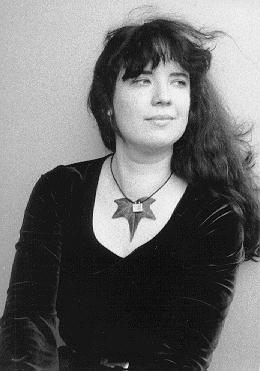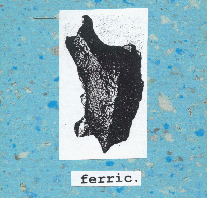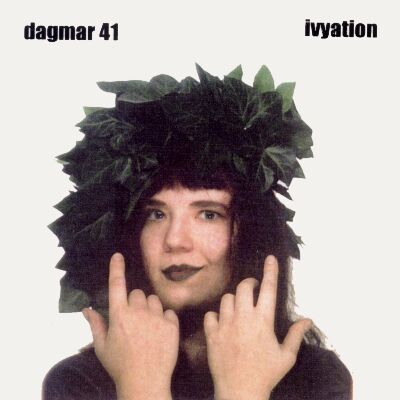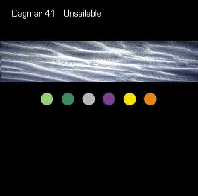
Image © 2000 Dagmar Klein
click on image to visit artists' website
Dagmar 41
album reviews and artist insights
experimental progressive folk rock
from the european continent
Review and HTML © Russell W Elliot 2000
all images used with permission
Formatted for 800 x 600 or larger windows
Last updated: 10 September 2000
The music of German folk rock artist Dagmar Klein, recommended to Musical Discoveries editors by one of our correspondents some months ago, is as experimental as it is original and independent. Indeed, Dagmar41 is not to be interpreted as Dagmar forty-one; instead, it is meant to be read as Dagmar for-one indicating the highly independent way she prefers to work. Fans of Xyra and Verborgen (review) are certain to find Dagmar's music of interest and worth a journey. Vocally she is a cross between Xyra and Sandy Denny with later allusions to British actress Eve Polycarpou. Our exclusive interview with the artist is incorporated within the reviews of three of her four CDs released between 1997 and 2000.
We asked Dagmar about the artists she was influenced by when writing her music. She told us, "When I started out in 1994 I was a full-time folkie with a little prog rock on the side—my absolute favourite band were Jethro Tull and although I've gone off them since, the sound is probably still evident from what I do when I get anywhere near flute!" She continued, "Since I started writing my own stuff, I've had so many recommendations and supposed influences come my way that I could not help check out more or less all the major women songwriters of the last few decades. Would you believe that until a few years ago I had no idea of who Kate Bush was?"
She continued, "The only obvious and occasionally conscious influence is that of Peter Hammill, evident in the 'weird' lyrics, although they make perfect sense to me, and my vocal free-form emoting on stage. He's my adopted uncle too; I adopted him on tour one night, after one too many avuncular enquiry about how my studies were going, where I was staying that night, etc. Then again, being called 'a female Hammill' does not exactly amount to copying him as that's fairly impossible with a woman's voice anyway."
 Ferric Cover Image © Dagmar Klein 1998 click on image for further reviews |
Ferric. Dagmar's first album is a self-released home studio project comprised of thirteen highly varied tracks ranging from moody ballads to upbeat original almost rocking numbers written between mid-1997 and early 1998. Instrumental arrangements include primarily strings and light woodwinds although the flute parts are highly notable. Multi-tracked harmony vocals add texture in the individual experimental style songs.
The album opens with "Picture Me and The Waterman" a thoughtful rock track followed by "Attitude." The soft ballad "Nænia" illustrates a more conventional singing style while arrangements are experimental in spots. We especially enjoyed the flute and the multi-tracked vocals in the folk rock tune "Headless in Siena." The title track's arrangements are perhaps the most experimental on the album with instrumental, percussive and vocal excursions spanning the broadest range. Dagmar writes, "chemically, it [is about] etching. And I needed a male listener to point out to me that it was actually about menstruation too."
"Great Wooden Horse" is highly illustrative of Dagmar's vocal talents, a light folk-like tune evocatively sung to piano accompaniment. The "New Lad Movement Song" is an original blend of jazz, blues and folk with some rock influences. Layers of vocals add to the amusing mood evoked by the lyrics. Sensual vocals are complimented by a stunning arrangement of flute, piano and strings in the the soft ballad-like tune "No Orpheus." We especially enjoyed the album's jazzy Spanish guitar inpired instrumental "The Guitar Sounds Marginally Better Than The Table." Flute and piano accompany Dagmar's vocal excursions in the concluding track "To Not Wake Up."
Interested readers will find mp3s and lyrics available at Dagmar's website. Click on the album cover above to find the page dedicated to the
Ferric album.We asked Dagmar who her favourite artists and bands were and who she found herself listening to all the time. She told us, "At the risk of sounding awfully pretentious: myself. That is not to say I listen to my own records—I don't normally.
Unsailable is the only one I've actually listened to at all after the final mix, but I play and mess around with my own songs most of the time. I'm afraid the old cliche is true that the more music you make the less you listen to other people's stuff. According to my record collection, my favourite artists are Peter Hammill, Tori Amos, Radiohead, Peter Gabriel, a German band called M. Walking on The Water, a neurotic Belgian by the name of An Pierle, and a number of people you've never heard of because they're mates of mine who put out a CD-R once in a while: Robert Gozon, Lobster, and Jan Kleinschnieder."
 Ivyation Cover Image © A New Day Records 1999 click on image for further reviews |
Ivyation. Dagmar's second album was released on the UK label A New Day Records (AND CD30, 1999) who has also released albums by the British progressive band Solstice. Dagmar contributes piano, keyboards, guitar, bass, assorted woodwinds and percussion in addition to vocals. Guests on the album include Jan Kleinschnieder, Stuart Gordon, Rene Van Commentee and Tobi Jung. As experimental as her debut, the album is more polished and richly produced primarily due to the instrumental arrangement improvements resulting from guest artist contributions. The album was recorded in Bristol, England.
Instrumental differences are notable from the opening track "Swim" with its vast guitar solo that perfectly compliments Dagmar's vocal excursions and style variations although the main melody is played on piano. Worldly instrumental and vocal flavours contribute to the highly varied but jazz-based texture of "Lay Lady Laughter." The flute arrangement is lovely.
Certainly the most progressive track on the album is the almost epic length "The Admiral Is Seeing Archangels." The electric guitar and keyboard textures and male backing vocals add depth and texture while Dagmar's vocal work varies from whispery to evocatively and sweetly sung parts to the powerful lead part in the song's chorus.
Dagmar wrote about the title track, "It is entirely improvised, layer after layer. The loop at the end is taken from one of my friend Rob's songs, taped, manhandled, threaded back into the cassette and played backwards. As with the last album, this one wasn't actually meant to have a title track until the very last minute." Enthusiasts of improvisation will likely enjoy this track while others may not.
Ivyation continues to develop experimentally with tracks "Now Be A Short Intermission," "Ten Nine Eight" and "I Is One" comprising the most unusual of the lot. "Time & Time" is evocatively sung accompanied by grand piano. Sensitive folkly layers of dramatic vocals and light percussion work quite well. We also especially enjoyed the string ensemble performance and extensive layers of vocals in the dramatic ballad "Fivewater." Dagmar ventures into reggae textures blending them with her other experimental styles in "The Geologists Are Happy," part of which was recorded while being sung into a telephone. Ivyation is available directly from A New Day Records. Details and mp3 samples are both available within Dagmar's website. Click on the album cover to access further information.Dagmar told us about how she developed, her musical training and about her education. "It's got nothing to do with what I'm doing now though. I started learning to play the recorder at age four, with a view to moving on to the clarinet once I was strong enough for that. My mother wanted me to play Mozart's Clarinet Concerto, and my father wanted a Ms Acker Bilk. But only after six years of toiling away at the bloody thing it turned out that I wasn't quite strong enough to maintain the physical air pressure all the way through a concerto, and on top of that I was growing massively disenchanted with classical music and how it's played." She continued, "Talk about either working your ass off to be a virtuoso or sitting in the back row of the orchestra counting 34 bars of silence and then going "toot"! So I asked my combined relatives to get me a flute for Xmas and forbade them to get me any flute lessons along with it. Then following a move to the big city and a severe case of growing pains, I took up the piano quietly and un-noticed, and before I even noticed it I'd written my first song. Since the "trial-and-error" approach waa such an enjoyable one, I've added a number of instruments to my repertoire since then, at a rate of roughly one a year: guitar, bass, percussion, and last but not least voice."
She told us about developing her vocal style. "As for developing the vocal style, I was under the false impression that I was a soprano for most of my life—mom's fault I think; she is—and petrified of singing in public anyway, though any development in the vocal department is simply due to more practice. I had singing lessons briefly, but it was a group tutorial, and all I got from that was the certainty that my voice is rather low and that I know what I want to sing anyway, away from the wobbly notes and screams and towards something a little more controlled yet still colourful."
Dagmar told us about how she writes her music. "Writing usually happens at the most inopportune of hours, like 2AM, or when I'm due to go to work. It's usually a musical idea that sparks the process off, more often than not simply the flopping down of hands on keyboard in a random fashion. The full song writes itself in less than 20 minutes usually, and then sits around waiting for a title or lyrical idea to go with it, which can take up to a few months. During this "pregnancy" I have ample time to actually learn to play the bugger of course, so by the time I know what it's going to be about I've got a fair idea of whether I need verses and choruses and things and where they go. The lyric once again comes out fairly quickly, traditionally by candlelight and with the aid of a sheet of paper, a pencil and no rubber. Aids concentration, you see, though I'm not yet far enough to actually write my lyrics in a book with a fountain pen as my favourite uncle Peter Hammill does!"
She told us about the recording process. "The recording has always been more or less a one-woman affair. I've had my own recording facilities from day one, starting from a four-track tape machine and graduating via a portable eight track hard-disk appliance to the PC-based software empire I have now; it's basically just that, a mixing desk, a load of wires, an ordinary stereo, a pair of very good headphones—since I live in a shared flat—and a pile of instruments and microphones."
She continued, "Of course there are lots instruments I can't play, or can't play well, so when I need a guitar solo, a drum part, or a cello line, I ring my friends or the members of the Mainz Acoustic Music Society and ask them round to listen and play. The engineering and mixing is entirely in my own hands too, except I usually distribute rough mixes among friends and ask for their sound-wise comments like whether those drums are a bit too trebly, etcetera. But generally I've developed into so much of a recording engineer over the years that they find it hard to teach me new tricks or to prove that my sonic quirks aren't intentional!"
 Unsailable Cover Image © Molecule Records 2000 click on image for further reviews |
Unsailable. The most recent album by Dagmar41 has fifteen tracks and is released on Molecule Records (411, 2000). Vocals and instrumentals are credited to Dagmar while additional guests listed for specific songs include Robert Gozon (voice, guitar and bass), Tobias Jung bass and voice), Jan Kleinschnieder (electric guitar), Gundula Krause, Jane Parsons (cello) and Jesco Weickert (drums).
The style developed in Dagmar's prior two albums continues to develop in her third with instrumental and vocal arrangements departing, becoming richer and having more depth but remaining equally inaccessible. The album opens with the instrumentally lush ballads "Read Me" and "Semaphore" then moves into the initially unusual-for-Dagmar groove vocal and guitar texture of "Defenestration," "Here Comes Iocasta" and "The Thursday Room." The departure from the earlier two albums is dramatic and immediate while some similarities, in voice only, actually remain. We especially enjoyed the songs' construction and Celtic whistle part in progressive rocker "The Thursday Room." We most enjoyed the upbeat instrumental and vocal fusion of "Normal Song"—a certain Dagmar41 favourite. "King Arthur's Cafe" has lovely vocal harmonies and innovative instrumental arrangements.
In "Marinade, "Eve (Cross Reference)" and "Ammonities" we were actually most reminded of British actress Eve Polycarpou in the Showcase performance of the
Scheherazade Musical both in the highly dramatic vocal and the style of the songs. The style is enhanced with additional vocal layers in the sensitive and dramatic ballad "Phosphorous." Strings or piano perfectly compliment Dagmar's vocal performance.We found the duet "Fins" a most enjoyable ballad and actually very West End oriented in its early construction. Dagmar's vocal sensitivity in this track exceeds all others. The artist's West End oriented style further develops in "Write With No Pen" a lovely progressive rock (think Jethro Tull) influenced duet. The album concludes with "Painted Sails." Partly nautical in its construction, the track blends lovely and sensitively sung vocalise with an equally stunning set of dramatically sung lyrics.
Dagmar41's latest album is a significant positive departure from the earlier two and with West End and progressive style influences taking hold, it should be further explored. Ordering information and sound samples are both available from the artist's website. Click on the album cover above for details.
Dagmar is involved outside her music career in quite a few endeavours. She told us, "I'm a teacher of chemistry and English by training, though I never entered school. Instead, I've spent two years on a PhD course in Recent English Studies at university, working part-time as a lab demonstrator and supervisor at the Department of Chemistry. The dissertation was called off a few weeks ago due to thematic and personal differences with my supervisor, and the result is going to be published as a book in a few weeks' time. For a preview click here and look for "Shouting!" Additionally, I'm the Acoustic Music Society's press officer where I do translations, typesetting and proofreading, teach English and Chemistry privately and play any old quiz show there is on German TV." She continued, "As of next March I'll be a fully employed project manager with a Frankfurt IT company, keeping an eye on their projects, contracts and wildly proliferating nicknames!"
We asked Dagmar about her live performances and she told us, "Ah, I'm the one who remembers least about them, as I usually lapse into a song-based state of blissful absent-mindedness. The last one was at an open-air festival this Saturday, and everyone except me got soaked, but I've also played to poetry-slam audiences—who then got treated to a few improvised bits of prose about why owls are not what they seem—on maliciously detuned electric pianos, in a church where a Kurdish family had set up temporary home, to drunk student audiences at the Bath Fringe Festival this year, and stalked by two press photographers who refused to believe I look stupid in profile and with my mouth open. They printed the pic anyway." Dagmar continued, "The only staple is that it's me and my piano or whatever electric equivalent there is. The mood can vary from quiet and delicate to raging furiously to playfully silly, usually all within the scope of one song." Not much different from her albums actually.
We asked Dagmar about her new website and she told us about the design. "The design of the website is that there isn't any! I wanted a change from the wildly neon-coloured on that Adrian The Rock had been maintaining for me during the early years."
Dagmar continued and told us about the artwork for the album covers, "They're all my own ideas, though
Ivyation was a bit of a lame compromise between me who wanted the image that is now the inside cover and the label who wanted something snappier and chose the photo of me with ivy on head insead. And yes, it is a real photo booth picture, and I actually ran around Mainz Central Station like this for a few minutes.The
Unsailable cover artwork grew out of a slide of desert sands I found in the street, and a few blobs of nail polish I originally dabbed on to the first black-and-white test print to make it more colourful. They stayed there. By the way, the marble woman on the back cover is not me after a run through Photoshop—as everyone seems to believe—but a real marble statue situated indside the Ultieme Hallucinatie Bar in Brussels, a favourite haunt of mine a few years ago. I admit she looks a bit like me though."Dagmar commented about the influence of the internet on her musical career and impact on her audiences. "It has brought me sone new fans and I'm still happy about every single one of them. Honestly I think I would not be able to sell my music at all if it wasn't for the web, as traditional labels and distributors won't have you unless you're big already. Here and now, people get the chance to listen, look, chat, and possibly buy. And then recommend. And I admit it's still one of the big kicks in my life to think that right now someone in South Africa or Holland or God knows where is listening to one of my songs."
Dagmar41's albums are available from sources listed within the artist's website. Details on how to obtain each one are available by clicking on the respective album cover above. The artist's first albums will appeal primarily to those that enjoy highly experimental or improvised music styles. There are samples available at the artist's website for those that wish to take the next steps online. We found Dagmar41's albums to be highly original and non-traditional in many respects. Each album a brave effort in its own right, they are worthy of further exploration and while the earlier ones are a
nice listen the latest one is worth a journey and is a must listen!Return to website contents